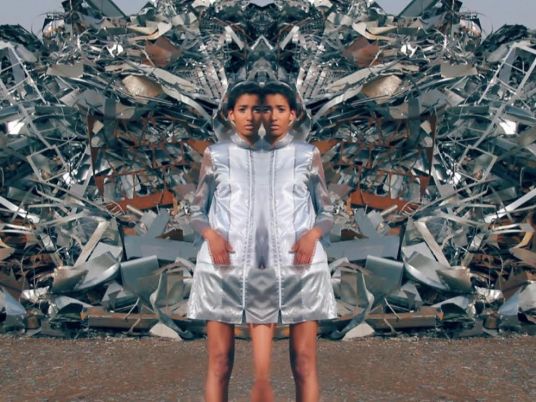Il Corpus Homanus,” the latest exhibition at Al-massar gallary, features the work of seven artists centered on the theme of the human body. Although the exhibition’s planners likely had good intentions in Latinizing the exhibition’s title, the result, “Il Corpus Homanus”, is an awkward hybrid between Latin and Italian. In fact the correct spelling should have been as followed : "Il Corpus Humanus".
Fortunately the art works that are exhibited since the 15th of November within the gallery have consistency, even if some artists displayed a more interesting approach to the human body than others. It is a little alarming, though, when an exhibition whose “raison d’être” is to glorify the body depicts characters fully dressed up. If not for the works of sculptor Essam Darwish and his fellow artist, painter Ibrahim el-Dessouki, hardly any skin would have been shown.
Essam Darwish’s abstract female torsos are undoubtedly the highlight of this exhibition. In blocks of polished bronze or chrome, he carves magnificent navels, slender stomachs, exquisite small nipples timidly bursting from the sculpture, and hardly sketched lower backs. The sculptures exhale both grace and innocence, while finding inspiration in a register slightly more erotic, which gives his work an additional dimension. Essam Darwish seems to be one of those rare artists who express their impressions of the human body – in this case exclusively female – in an abstract and poetic way.
Not all of the numerous paintings by Ibrahim el-Dessouki provide the visitor with a clear vision of the artist’s thoughts on the human body though. “Nude” is the painter’s most eloquent expression of his artistic vision as far as the body is concerned. It depicts a naked woman fast asleep on a simple mat. Although the woman’s generous curves, curled position and thick hair fixed into a bun is a reminder of European classical paintings from the Renaissance, the composition is elegant in a more modern way. The painter uses a particular technique which involves spreading a layer of white oil paint underneath other color layers. “Then I use a razor to reveal the layers underneath, which creates this peculiar effect,” adds el-Dessouki, moving his arm frantically while displaying his work. Another interesting painting depicts a buxom model standing with her back turned towards the viewer, seemingly standing in a narrow street, a dark shawl partly covering her full body “This is a woman that I saw strolling in my neighborhood when I was young, and she personifies nostalgia,” says the painter.
The exhibition also features the work of promising young artist Karim el-Quraity who was given the chance to exhibit his latest work to date. His reflections on the human body are more abstract than the rest of the pieces shown in the gallery, especially his large diptych portraying a baroque armchair and two crouching male bodies, that mirror the contours of the chair. El-Quraity’s distinctive style is conveyed through the association of three leading colors: black and gray, on an acrylic white-washed background. “When I paint I use the technique of the sculptor, who starts with a uniform block and removes bits and pieces until the final shape emerges,” explains the artist. “I also start with one color and then I remove parts of it to highlight what lies beneath,” he adds, pointing to a large acrylic painting entitled “Safe Heaven” that depicts three male bodies entangled and shriveled, desperately trying to join forces against an unseen, looming threat. In a nearby portrait, el-Quraity uses splashes of paint from the same set of colors: brown, black and white. The model’s features are barely readable, except its frowning eyebrows, but the gloom the painting exudes is overwhelming.
The last interesting piece from the same artist, titled “Fading,” dates back to 2006. Even though the connection with the human body theme is somewhat stretched in the case of this portrait, it is exceptionally gripping. A young man’s upper body and face are facing a window, against which rain seems to be pouring. What strikes the viewer of this piece is the fact that the rain washes away the young man’s features while his clothes remain untouched, as if his personality is falling into pieces or decaying rapidly.
The extreme sadness of el-Quraity’s artwork is nearly matched by that of Haytham Nawar, who deftly sketches in pencil the motionless body of a man lying at the bottom of a bathtub in “Still”. The left hand of the man emerges from the water so slowly that the water does not even ripple. His body is fully nude except for an indistinct piece of cloth covering the genitals, which, raises the specter of censorship. Another, joint portrait illustrates the half-immersed face of a man who we can easily imagine lying unmoving in a bathtub, his dark eyes devoid of life. Something indefinable is exhaled by those pencil drawings, a feeling close to despair and loneliness.
Three other artists have their pieces featured in the Masar exhibition: photographer Nermine Hammam, calligrapher Sameh Ismael, and painter Sami Abul Azm. Nermine Hammam’s retouched photographs are extensively displayed in the gallery premises. Her artistic style cannot be mistaken, as she reworks photographs into painterly images. The well-known calligrapher Sameh Ismael presents the viewer with two pieces to be respected not for their aesthetic aspect, but rather for their innovative approach. He pushes the concept of calligraphy by presenting two 3D pieces which fall halfway between sculpture and painting. He created a bust made out of real leather that emerge out of the canvas when observed from the side. If you stand right in front of it, the composition appears flat. Finally, Abul Azm’s paintings depicting the reflections of lonely women are proof of the artist’s masterly brushstroke, and his tremendous skill in portraying psychological turmoil.
Al-massar Gallery
Behler’s Maison 157b, 26 July St. Zamalek, Cairo
202-27368537
2-0100670705
Opening Hours: Saturday-Thursday 11 AM – 9 PM
The exhibition runs until December 9




